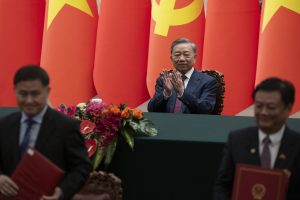A question for many observers of Vietnam’s foreign relations was which country To Lam, the newly appointed general secretary of the Communist Party of Vietnam (CPV) would choose as the destination of his first foreign visit. That question now has an answer.
On August 15, the Vietnamese Ministry of Foreign Affairs confirmed that Lam and his wife will pay an official visit to China from August 18-20 at the invitation of his Chinese counterpart Xi Jinping. What are the expectations and messages conveyed by this visit for Vietnam-China relations?
To begin with, it can be said that Vietnam-China relations are at their best and most stable since the normalization of relations between the two countries in 1991, and especially in the 13 years since Xi took full power in China. During this period, although there have been occasional hiccups in the relationship, particularly in the South China Sea, and while the trade balance still heavily favors China, the two countries reached a common understanding and established a “China-Vietnam Community with a Shared Future carrying a Strategic Significance” during Xi’s visit to Vietnam last December.
It goes without saying that the stable Vietnam-China relationship is partly due to the personal relationship between Xi and the late CPV General Secretary Nguyen Phu Trong, who suddenly passed away on July 19. The Xi-Trong relationship can be described as based on mutual understanding, respect, and support for the overall development of both countries. However, it is also based on many similarities between the two men.
Both Trong and Xi became heads of their respective Communist Parties around the same time. Both focused on consolidating the power of the Communist Party as the sole ruling party and emphasizing a version of Marxism-Leninism suitable to the circumstances and development path of their respective countries. Both also launched uncompromising anti-corruption campaigns to cleanse the party and state apparatus. Many believe that Trong’s “blazing furnace” anti-corruption campaign is a duplicate of the “tiger and fly-swatting” that Xi carried out during his own anti-corruption campaign.
However, the parallels are limited and Trong’s “blazing furnace” seems to have far surpassed Xi’s efforts, leading as it did to the resignation of two incumbent presidents, a chairman of the National Assembly, two deputy prime ministers, and a standing member of the Secretariat. When Trong passed away, Xi went to the Vietnamese Embassy in Beijing to mourn his passing and bowed three times in front of a portrait of the departed Vietnamese leader.
Given the extent to which he contributed to such good relations between the two countries, people, including on the Chinese side, have speculated whether Vietnam-China relations will enter a phase similar to that which followed Ho Chi Minh’s death in 1969. The post-Ho Chi Minh period witnessed a rift in relations between Vietnamese and Chinese communists, culminating in the Chinese invasion of February-March 1979 and lasting until 1989. This war caused material damage, loss of life, and left an indelible psychological scar on the Vietnamese people, instilling negative attitudes towards China. It also left a very bad impression of the communist world as a whole, such that nations that viewed each other as “both comrades and brothers,” and whose closeness was likened to “lips and teeth,” could come to blows.
A day before Trong’s state funeral, a Chinese scholar wrote an article titled “Vietnam-China relations in the ‘post-Nguyen Phu Trong’ era should not show any deviation” (冯超: “后阮富仲时代”的中越关系,不应出现任何偏航). There is no evidence to suggest that the article was a warning from the Chinese leadership, but it is certainly a noteworthy reminder. Meanwhile, the Chinese leadership has also tested Vietnam’s reaction. In separate incidents on August 2 and August 5, a Chinese drone, identified as a Wing Loong-10 unmanned aerial vehicle took off from China’s Hainan Island and illegally intruded into Vietnam’s airspace and exclusive economic zone, flying along the coastline for approximately 800 kilometers before turning back near Phan Rang province.
Most observers believe this is China’s response to the joint drills between Vietnam and the Philippines in the South China Sea. However, this incursion can also be seen as a test of Vietnam’s China policy under the new CPV chief, as the second incursion took place two days after To Lam was elected to the post. Notably, the Chinese side deliberately turned on the aircraft’s trackers, while in previous instances they did not. Vietnam has remained silent about the incident.
In this context, beyond the diplomatic rhetoric of officials from both countries, that To Lam chose China for his first foreign trip just two weeks after becoming the CPV chief, sends at least three messages. First, that Vietnam attaches importance to the party-to-party relationship, considering it a strategic guidance for the development of relations between the two countries.
Second, To Lam wants to affirm that he will continue to inherit the high-level diplomatic legacy of his predecessor with Xi Jinping. Notably, this time, Lam is visiting China in the dual capacity of both general secretary and President, meaning he is in a position completely equivalent to Xi. This is the first time a Vietnamese leader has visited China in both these capacities since the era of Ho Chi Minh.
Third, the visit sends the message that Vietnam is consistent in developing its relations with China, considering it a strategic choice and top priority in its foreign policy. Any concerns about deviation in Vietnam-China relations are therefore unnecessary.
The visit to China by the CPV, amid silence over the incursion of Chinese military unmanned aircraft, can be seen as a strategic silence within the overall framework of Vietnam’s strategic patience toward the disputes in the South China Sea. It is also a message about the consistent expectation of the visit, which is that Vietnam wishes to maintain stable Vietnam-China relations and that both sides need to strengthen political trust through sincere actions rather than through threatening or bullying behavior.
































